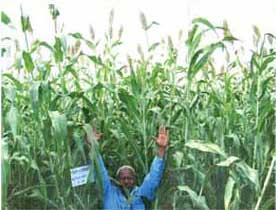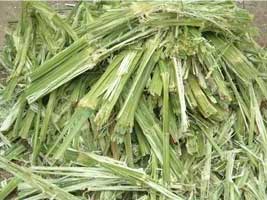 Hyderabad, India Hyderabad, India
September 20, 2006
By
Dr. William D Dar, Director General,
ICRISAT
Developing nations are looking
towards biofuels to help reduce their spiraling foreign oil
import costs, and to mitigate pollution and global warming. The
drylands, often neglected compared to more favorable areas, can
contribute importantly to a bio-fueled future. Our challenge—and
opportunity—is to ensure that the dryland poor are not left
behind.
Bio-ethanol: an idea whose time has come
Contrary to common belief that
massive subsidies are needed to promote bio-ethanol, it is now
price-competitive with petrol (gasoline) in India without
subsidies, due to recently skyrocketing petrol prices. This is
the case even after adjusting for energy-equivalency (one liter
of petrol has the same energy content as 1.5 liters of ethanol).
India is targeting a 10% blend of ethanol in its national petrol
supply.
The constraint is not the cost of
ethanol production; it is the supply of raw materials. This is
where ICRISAT and partners come in.
 Sweet,
sweet sorghum Sweet,
sweet sorghum
Most bio-ethanol in India is
produced from the molasses left over from the refining of sugar
from sugarcane, but the supply of molasses is insufficient and
not reliable enough for costly ethanol production facilities
that need to keep working around the clock to pay off. We are
excited about the potential of a little-known dryland crop,
sweet sorghum (photo), to help fill this supply gap. ‘Sweet’
varieties of sorghum store large quantities of energy as sugar
in their stalks, while also producing reasonable grain yields.
Sorghum, like sugarcane and maize,
exhibits C4 metabolism – making it more efficient at converting
atmospheric carbon dioxide into sugar than most plants. As a
dryland crop, sorghum requires far less water than costly
irrigated sugarcane, making it more accessible to the poor. The
juice squeezed out of sweet sorghum stalks contains about 15-20%
sugar that can be fermented into ethanol more cheaply than from
sugarcane molasses—and with even greater energy savings compared
to maize grain, which has to be hydrated and converted from
starch to sugar before it can be fermented.
India’s
National Research Centre
for Sorghum (NRCS) has long recognized the potential of
sweet sorghum and has developed excellent open-pollinated
varieties and some hybrids. Our complementary contribution has
been the identification of high-sugar parent lines for hybrid
breeding from our global germplasm collection (another payoff
from that immensely valuable resource). Hybrids are also less
photoperiod sensitive so they can be grown year-round, smoothing
out supply variations for the ethanol production facilities.
Making it happen
|
 |
|
After
crushing, the stalks are excellent for cattle fodder or
to fuel the ethanol production facility |
We are stimulating public-private
collaboration to move sweet sorghum from a good idea on the
shelf, to impact on the ground. Our hybrid sorghum program
receives substantial support from the private sector (30 seed
companies) through our innovative Hybrid Seed Consortium, so the
seeds are moving quickly through the research-to-development
pipeline.
At
ICRISAT headquarters in
Patancheru, India we’ve also formed a public-private partnership
with Rusni
Distilleries (P) Ltd. Rusni ensures that seeds of the
highest-sugar sorghum varieties identified by ICRISAT and NRCS
reach farmers so they can increase their productivity. Rusni
also helps farmers by transporting the stalks from farms within
a 30 kilometer radius of the plant, and providing more distant
farmers with technologies to crush the stalks and reduce the
juice into syrup that can be moved cost-efficiently to the
ethanol production plant. Lessons we are learning from this
partnership will enable the technology to scale up faster and
more widely in the coming years.
Bio-diesel
Forty percent of India’s oil
imports are consumed in the form of diesel fuel, and demand is
rapidly growing. The nation has adopted similar blending targets
as for bio-ethanol (10%). Bio-diesel is even more
environment-friendly than bio-ethanol because it requires less
energy to process. It is also much less polluting than
fossil-fuel diesel.
As in the case of bio-ethanol, the
biggest constraint for takeoff of the bio-diesel industry is
insufficient supply of the raw material. To fill this gap, vast
wasteland areas, estimated at 38 to 187 million hectares in
India, that include areas suitable for dryland-hardy bio-diesel
crops can be made available to local communities. While
providing an income-earning opportunity for the poor, these
perennial tree and shrub crops also help rehabilitate these
lands by building the fertility of their soils.
|
 |
|
Japtropha grows vigorously in dryland Africa.
Note the oil-rich fruits |
Two contrasting dryland species
are especially interesting: Pongamia pinnata, a leguminous tree
adapted to wetter wastelands with problem soils; and Jatropha
curcas, a more drought-tolerant shrub adapted to well-drained
wastelands and widely grown as a homestead boundary plant in the
Sahel. Both produce fruits containing about 35% oil suitable for
bio-diesel.
Women are the main cultivators and
processors of bio-diesel crops at the village level.
ICRISAT is working with
poor women united in self-help groups to start Pongamia
enterprises in remote tribal areas of Andhra Pradesh, India, and
working with India’s national research system to identify
high-oil varieties as well as better cultivation methods.
India is also promoting Jatropha;
it is grown along rail lines and the oil is blended with
petro-diesel to power trains. Japtropha is also widely grown as
a hedgerow boundary plant in Indian and African villages. We are
exploring the genetic variability in Jatropha on both continents
to find higher-oil types to increase its income-earning
potential.
A future of possibility
Some question whether biofuel
crops will compete for land with food crops, driving up food
prices. To be sure, there are risks; however we look at this
issue differently.
The dryland poor need food to eat,
but they also need opportunities for economic growth if they are
to escape poverty. Sorghum production in India has been
declining for many years due to urban preferences and subsidies
for rice and wheat, lessening economic opportunities for dryland
agriculturalists. The same trends will probably develop in
Africa in decades to come. Increases in area sown to corn or
sugarcane for ethanol, in contrast would take the most valuable,
fertile lands out of food production.
Through research-for-development,
we can help transition the sorghum enterprise from a human food
to a cash crop for bio-ethanol as well as producing grains and
stalks that feed humans and livestock. We can help rural
villages gain greater self-sufficiency in energy production
through bio-diesel crops. The benefits are multiple and
significant: easing poverty, reducing air pollution, mitigating
global warming, and rehabilitating degraded wastelands.
Biofuels are a major emerging
trend that can have a large impact on dryland development. Now,
in the early stages, is the time of greatest opportunity to
ensure that the poor capture a large share of the benefits. Raw
materials are a key constraint that we are helping to overcome
in a pro-poor manner through our dryland crops expertise and
partnerships with investors, governments, non-governmental
organizations and the private sector.
Many twists and turns still lie ahead of us on this road, but I
am confident that with your support and partnership we will be
able to power a better future for the drylands through biofuels.
By Dr. William D Dar, Director
General, ICRISAT |